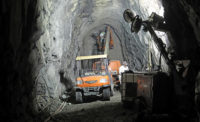New York City-area transportation officials urged a local construction group today to help lobby for a fair--and lion's--share of reauthorized funding in the next version of TEA-21. Speaking at a Professional Women In Construction forum, officials from federal, state and advocacy agencies noted that with scarce sources of funding and fewer Congressional champions of New York transportation, emphasizing the area as a security target and densely populated business center would be vital in garnering federal support for big-ticket construction projects.
Chris Boylan, deputy executive director of the New York Metropolitan Transportation Authority, said that billions of dollars worth of planned projects--such as the East Side Access connector and a new Second Avenue Subway--should not come out of the $21 billion in federal funds earmarked for rebuilding downtown Manhattan's transportation network. "I made the case that there is no relationship there," he said of his testimony before a Congressional appropriations committee. He added that if New York City were to host the 2012 Olympic Games, "it would be a tremendous engine for these projects."
But Janine Bauer, executive director of the Tri-State Transportation Campaign, noted that the city's subway system alone needs $31 billion over the next 20 years just for maintenance. "Any project under a billion dollars is cheap," she said of the scope of money needed. Patricia Noonan, senior director of research and policy for the NYC Partnership, a group representing area businesses, urged that advocates channel national post-9/11 attention to security and economic recovery into increased transportation funding for New York City.
Robert Yaro, president of the Regional Plan Association, predicted that taxpayers will be reluctant to embrace gas tax increases that would fund transportation reauthorization, particularly with a "conservative Republican" as President. He described the Eisenhower Administration era as a time when national transportation systems were built to facilitate military movements in the face of war, and said the time has come again in the war on terrorism. "If Eisenhower did it, George W. can," he said. Every U.S. major metropolitan area is so congested currently that "economic growth needed to win what could be a generations-long war" will be hampered, he added. Right now, "terrorism isn't needed to shut down the Long Island Expressway in the morning, just a heavy dew," he said.
Leslie Maeby, project director for the New York State Dept. of Transportation, said a bill on TEA-21 reauthorization isn't expected until March 2003. New York State, which received about $1.5 billion last year in TEA-21 apportionments, must contend with other states who want more funding for rural transportation, more return on their gas tax revenue input despite relative scope of need, and a House that has not restored full Revenue Alignbed Budget Authority imbalances that caused an $8-billion shortfall in highway funding this year. Boyland added that the MTA "has 30% of the nation's ridership but only 14% funding of the national share" for transit. Noting Amtrak's tenuous financial status, he said, "We love Amtrak...but we don't want it in the transit pot...we carry more riders in three days than Amtrak does in a year." The MTA needs to spend more than its current $700 million a year to expand. Projects like East Side Access and Second Avenue Subway may help make the case to Congress, he said.
Bids went out for the first contract on the East Side Access project this week, an estimated $1-5 million job to remediate a train yard in preparation for tunneling under Grand Central Terminal. Earlier this summer, the U.S. DOT graded $14.59 million for design activities for the East Side Access project and $4.98 million for preliminary engineering work on the Second Avenue Subway.




Post a comment to this article
Report Abusive Comment